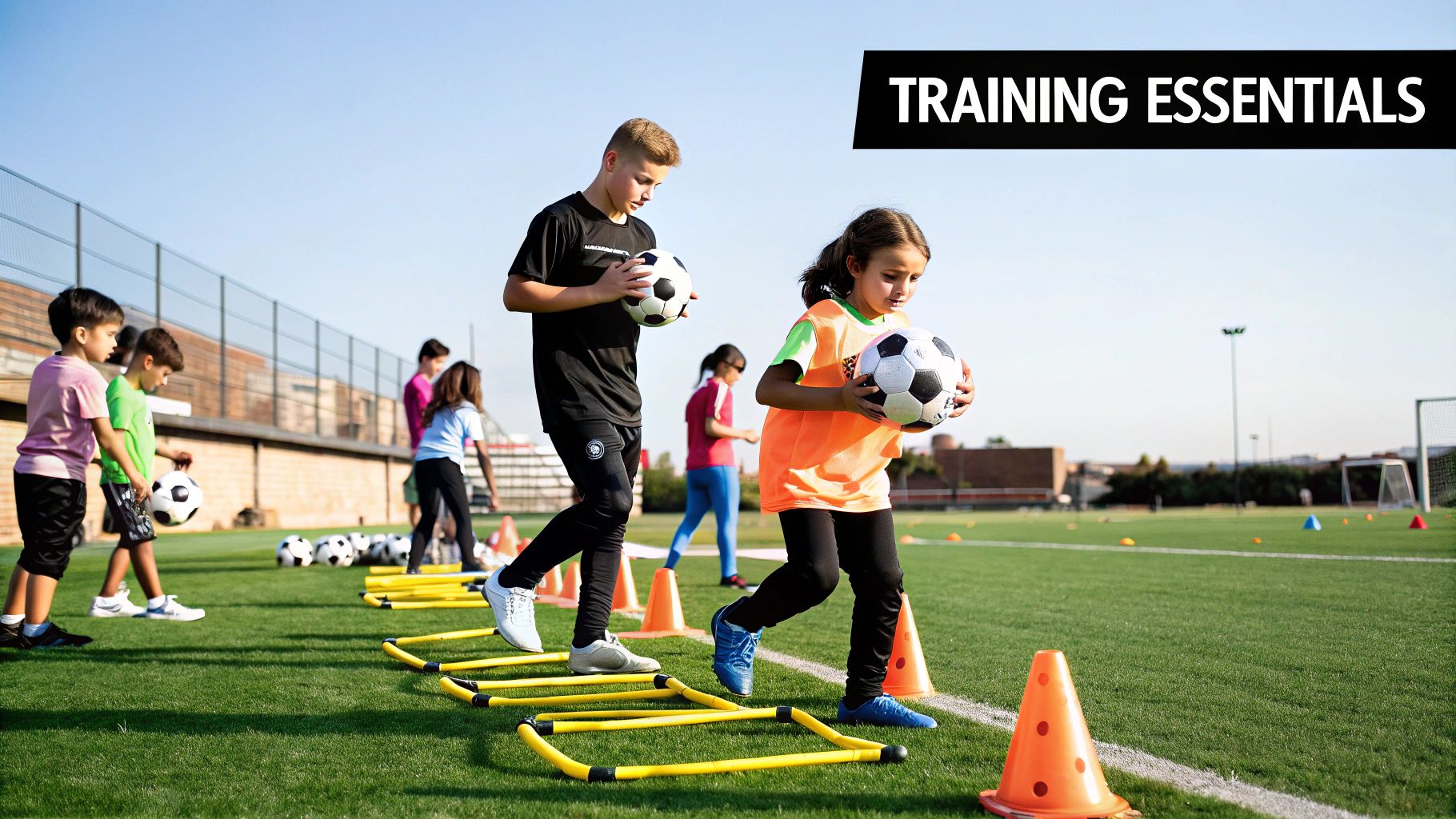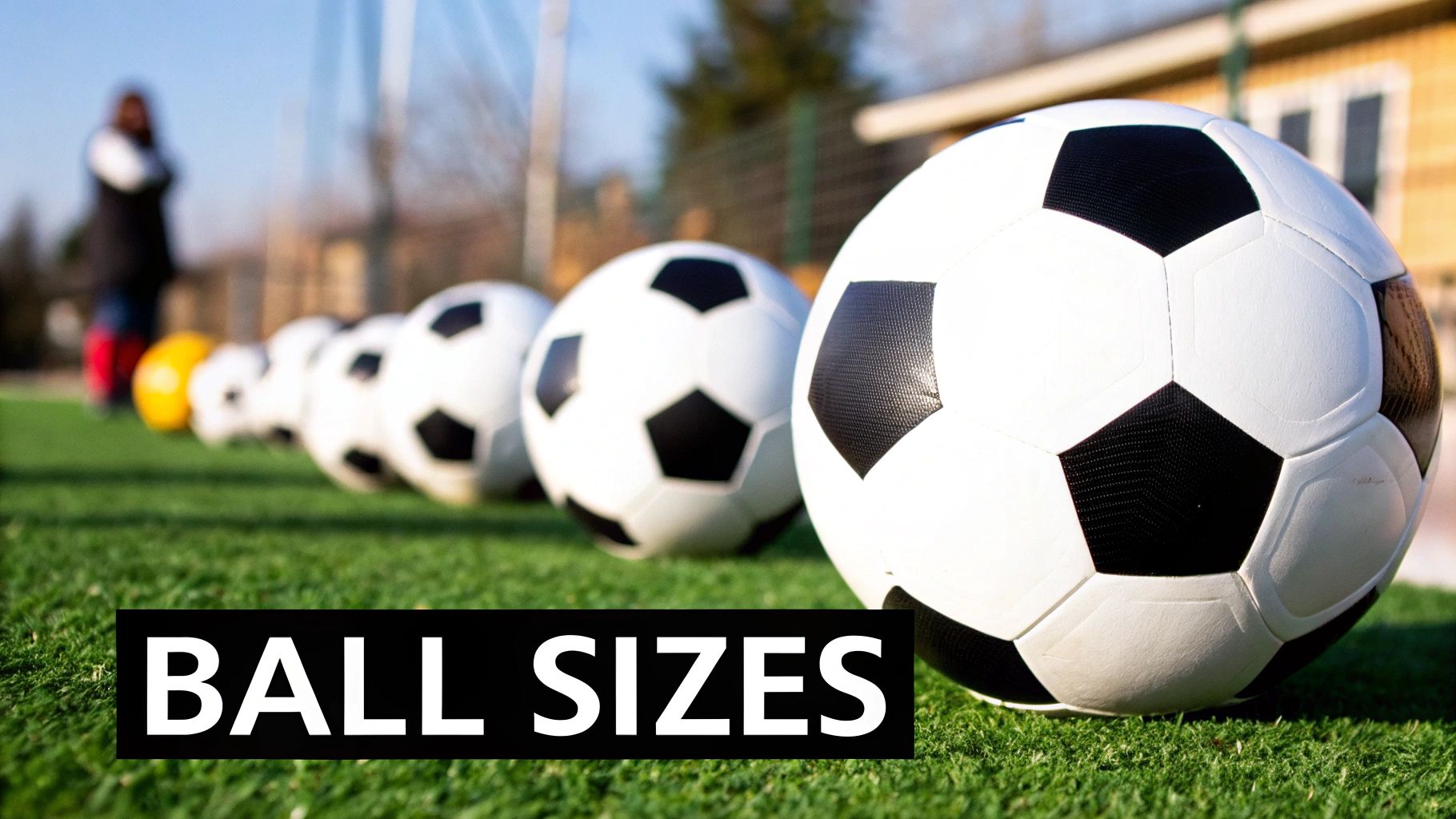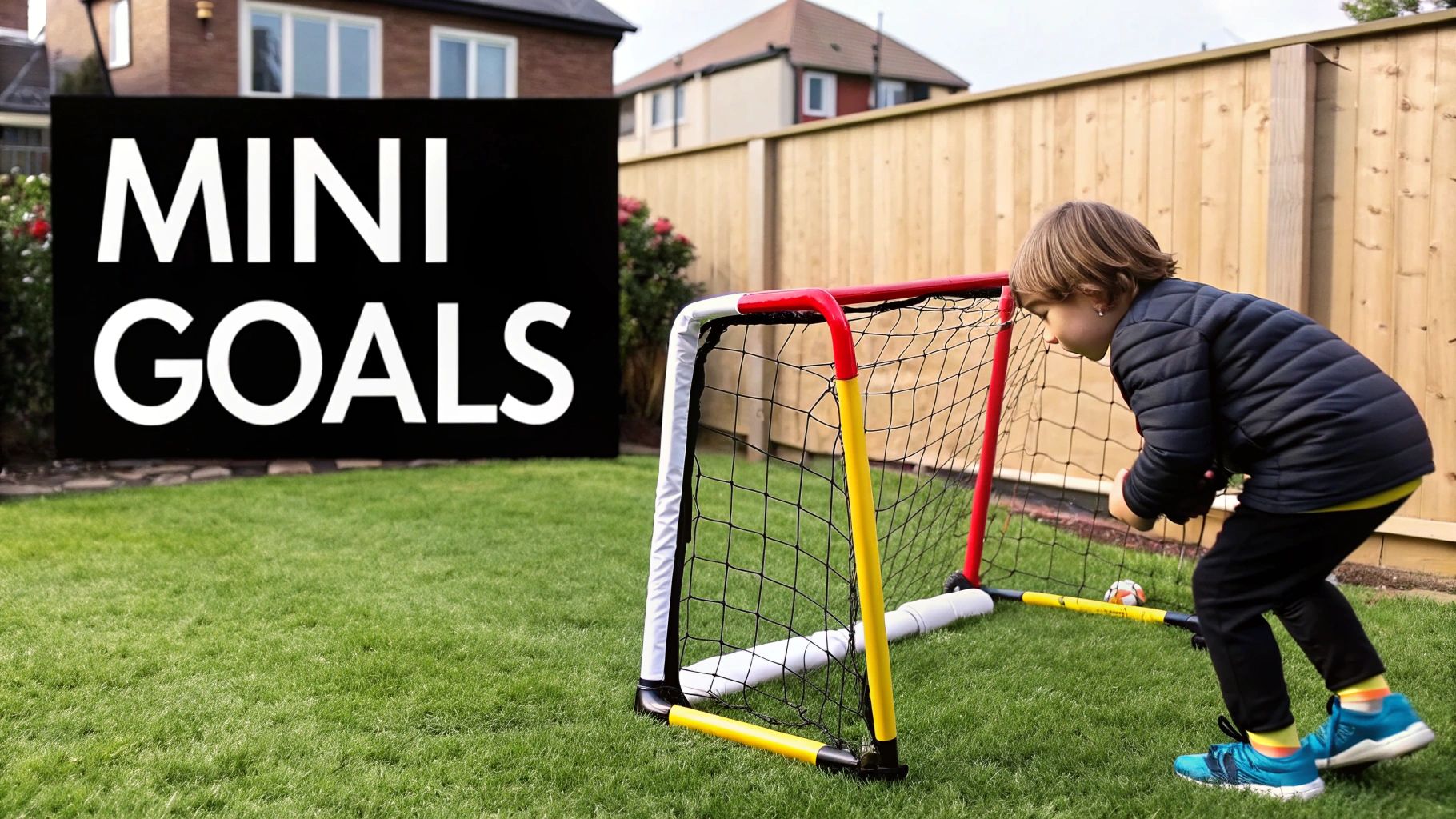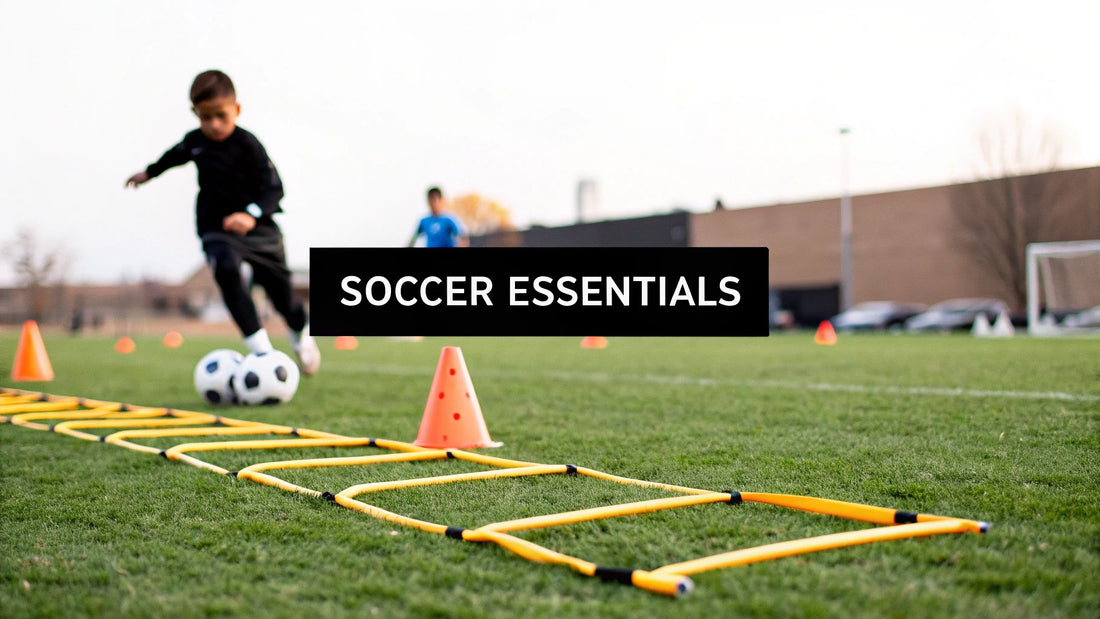Getting your child started in football is a brilliant moment, but let's be honest, figuring out what soccer training equipment for kids they actually need can feel a bit much. The secret is to keep it simple, focus on gear that’s right for their age, and make sure it’s all safe and, most importantly, fun. This guide cuts through the noise to help you build a kit that will support your young footballer's development without you having to spend a fortune.
Building Your Young Footballer's First Kit

Starting their journey in the beautiful game is a fantastic step for any kid. It’s where they’ll make friends, improve their coordination, and learn what it means to be part of a team. But when you look at all the gear available, it’s enough to make your head spin.
The good news? You don't need a pro-level locker room to get them on the pitch. The goal is simply to give them a solid foundation that helps their passion and skills develop naturally.
The right equipment does more than just prepare a child for a match; it builds their confidence. When gear fits well and is suited to their age, kids feel more capable and ready to learn.
Why the Right Gear Matters
Choosing the right equipment isn't just about ticking boxes on a list; it genuinely shapes their experience on the pitch. Age-appropriate gear ensures a few key things:
- Safety and Protection: Properly fitted shin pads and the right boots are non-negotiable. They’re the first line of defence against knocks and injuries.
- Skill Development: A football that's too big or heavy is just frustrating. It can stop a young player from learning the proper technique for kicking and control.
- Lasting Enjoyment: If their kit is comfortable and works for them, they can forget about it and just focus on having fun. That’s what keeps them coming back.
Think of this guide as your playbook. We’ll walk you through the essentials, from the ball itself to simple training aids like agility cones, ensuring you feel confident you’re getting exactly what your young player needs.
The Essential Gear Every Young Player Needs

Before your child steps onto the pitch for their first practice, there are a few non-negotiable bits of kit they'll need. Think of this as their starter pack—the absolute essentials that ensure they're safe, comfortable, and ready to fall in love with the game.
Getting these basics right from the very beginning makes all the difference. It sets them up for a fun, positive experience instead of a frustrating one.
With over 2.5 million kids registered in grassroots football clubs across England alone, the demand for proper youth equipment is massive. We're talking about everything from smaller footballs and kid-sized boots to lightweight shin pads. These aren't just scaled-down adult versions; they're designed with a purpose.
Choosing the Right Football
The football itself is the obvious starting point, but getting the size right is more important than most new parents realise. Handing a five-year-old a full-size ball is like asking them to run in adult shoes—it’s awkward, frustrating, and can even teach them bad habits.
- Size 3: This is the smallest official ball, perfect for players aged 5-7. It's lighter and smaller, helping little feet build confidence with their first touches, passes, and shots.
- Size 4: As kids get a bit older, usually between 8-11, they graduate to a size 4. It’s the ideal stepping stone, preparing them for the weight and feel of a full-size ball without being overwhelming.
- Size 5: This is the standard, full-size football used by players aged 12 and up, right through to the professional game.
A correctly sized ball is a game-changer. It allows for proper technique development from day one, preventing bad habits from forming and making the game far more enjoyable.
Safety Gear You Cannot Skip
While the ball is for the game, this next bit is for the player. Safety is paramount, especially for kids who are still developing their coordination and spatial awareness on the pitch. These two items are absolutely essential.
Shin Pads
There’s a reason shin pads are mandatory in almost every league on the planet—they protect the shins from painful kicks and collisions. Look for pads that fit snugly without restricting movement. For the youngest players, models with built-in ankle socks are highly recommended. They offer extra protection and stability, and they're less likely to slide around.
Football Boots
The right footwear is critical. Football boots are specifically designed to give players the traction they need for the quick stops, starts, and turns that define the game. The type of stud you need depends on the pitch: firm ground (FG) boots are your all-rounders for grass, while artificial ground (AG) boots are a must for modern 3G or 4G surfaces.
Ensure they have a snug but comfortable fit. You want to leave a little room for growth, but not so much that their foot is sliding around inside. For a full rundown of gear, check out our guide on essential football training equipment.
Matching Equipment to Your Child's Age and Stage
Choosing the right football gear for your kid isn't a one-size-fits-all job. A six-year-old just finding their feet on the pitch has completely different needs from a twelve-year-old starting to play more competitively. The secret is to tailor the equipment to their developmental stage – it's crucial for building skills, staying safe, and most importantly, keeping the game fun.
Getting this right means your investment actively helps them improve. It prevents you from buying advanced gear too early or sticking with the basics for too long, ensuring your child gets the most out of every practice session.
Ages 5-7: The Foundation of Fun
For the youngest players, football is all about discovery and pure enjoyment. The main goal here isn't to master complex drills; it's to build basic coordination and spark a love for the game. The equipment should reflect this playful spirit.
- Focus: Fun, coordination, and getting comfortable with the ball.
- Key Equipment: A Size 3 football is essential. It's lighter and smaller, making it perfect for little feet. Forget tall, rigid cones – brightly coloured, soft disc markers are far better for setting up simple dribbling paths without being intimidating.
Ages 8-10: Building Core Skills
As kids grow, so does their coordination and understanding of the game. This is the stage where training equipment can start to focus more on developing core football skills like passing, shooting, and ball control.
It’s now much easier for parents to find the right gear, too. Child-friendly equipment like smaller balls and adjustable goalposts are key for skill development between 6 and 12 years old, and the growth of e-commerce has made it simple to get what you need from top youth sports brands across the UK. You can learn more about trends in the kids' sports equipment market.
This is the perfect age to bring in tools that offer repetition and instant feedback. A small pop-up goal in the garden is brilliant for encouraging shooting practice. A basic football rebounder can also help them work on their passing and first touch, even when they’re training alone.
For this age group, the right equipment acts like a patient coach. A rebounder, for example, always returns the ball, giving a player endless opportunities to practise receiving and passing without needing a partner.
Ages 11-13: Honing Athleticism
Once players hit their pre-teen years, their training often becomes more structured. They're physically stronger and ready for more demanding drills that build not just skill, but also speed, agility, and overall fitness.
This is when more advanced soccer training equipment for kids really starts to pay off. Introducing agility aids helps them develop the quick footwork and explosive movements that are vital on the pitch.
The image below shows two fundamental pieces of kit for agility training.

As you can see, simple tools like cones and agility ladders form the very foundation of athletic development for young players.
These pieces of gear are incredibly versatile and can be used for countless drills to improve a player's speed and coordination. You can also introduce small hurdles to work on jumping and explosive power, preparing them for the physical demands of a competitive match. You can find durable agility ladders and cones perfect for this age group at soccerwares.com.
To make it easier, here's a quick summary of what equipment works best for each age group.
Age-Appropriate Soccer Equipment Guide
This table breaks down the recommended equipment for each stage of your child's football journey, focusing on what will help them develop safely and effectively.
| Age Group | Recommended Ball Size | Training Focus | Key Equipment Recommendations |
|---|---|---|---|
| 5-7 | Size 3 | Fun, coordination, ball control | Soft disc markers, small pop-up goals |
| 8-10 | Size 4 | Core skills, passing, shooting | Rebounders, adjustable goals, slightly larger cones |
| 11-13 | Size 4 | Agility, speed, fitness | Agility ladders, small hurdles, resistance bands, full-size training cones |
Choosing the right gear at the right time sets your young player up for success. It keeps them engaged, builds their confidence, and ensures they're developing their skills in a way that’s both safe and fun.
Using Training Aids to Develop Specific Skills

Once your child has the essential gear sorted, it's time to consider training aids. Think of these as specialised tools, each designed to sharpen a different part of their game, from lightning-fast footwork to pinpoint shooting.
This isn't about setting up complicated, professional-level drills in the back garden. It's about having fun while building skills. With just a few key pieces of soccer training equipment for kids, you can help them grow in confidence and ability, without it ever feeling like a chore.
Mastering Agility and Footwork
Quick feet are everything in football. They're what allow a player to change direction in a heartbeat, dodge a defender, and react to a loose ball first. Agility ladders and low hurdles are brilliant for developing this muscle memory.
- Agility Ladders: These are perfect for teaching rapid foot placement and coordination. Simple drills, like running through the rungs one foot at a time or shuffling side-to-side, build the quick-twitch reactions needed on the pitch.
- Small Hurdles: Setting up a line of mini hurdles encourages explosive little jumps and quick steps, which is fantastic for improving a player’s power and acceleration over those first crucial yards.
It's no secret that grassroots football is booming, and with it, there's been a noticeable rise in spending on this kind of gear. UK market data shows a steady growth in sales of training aids like agility ladders and cones. You can read more about the growth of the football equipment market if you're interested in the data.
Sharpening Ball Control and Dribbling
Keeping the ball under close control while on the move is what separates good players from great ones. For this, cones, markers, and training poles are the classic, must-have tools of the trade.
A simple set of cones can be used to create endless dribbling challenges. This versatility makes them arguably the most valuable piece of training equipment for a developing player.
Setting up a slalom course with cones forces a player to make tight turns and keep the ball glued to their feet. As they get better, you can introduce taller markers to add another layer of difficulty. To learn more about how they can be used effectively, check out our guide on the benefits of soccer training poles.
These simple exercises transform what could be a boring practice into a dynamic challenge, making skill development feel more like a game. That's exactly what helps build the control and confidence they need to take on opponents when it really counts.
How to Choose Safe and Durable Kids' Football Gear
Picking the right football training equipment for kids can feel overwhelming, but if you focus on a few key details, you’ll end up with gear that lasts. It really all comes down to balancing three things: safety, durability, and overall value.
Spotting quality materials is your first step. For bigger items like portable goals or rebounders, look for sturdy steel frames and robust netting that can handle hundreds of powerful shots. That flimsy plastic goal might seem like a bargain, but it rarely survives a full season of enthusiastic play.
When it comes to safety, some things are simply non-negotiable.
Think about the construction of shin pads. A good pair needs a hard outer shell to deflect impact and a dense foam backing to absorb the shock. This is crucial protection against stray kicks and collisions on the pitch.
Finding the Right Balance
Deciding between a premium brand and a more budget-friendly option often depends on the specific item. For something like football boots, which a child will likely outgrow in a year, a solid mid-range option often gives you the best value for money.
However, for equipment you expect to use for years—like a portable goal—investing a little more in a well-reviewed, sturdy model is a much smarter long-term choice.
Think of it as a quick pre-purchase checklist:
- Read Reviews: See what other parents are saying about wear and tear. Their real-world experience is invaluable.
- Check Materials: Prioritise steel over plastic for frames and look for multi-layered foam in protective pads.
- Consider Stability: For goals, check for secure anchoring systems to prevent them from tipping over during play.
Making smart, informed decisions means you can support your child’s passion without breaking the bank. For a complete overview of what to include, check out our comprehensive guide on creating a kids' football training kit.
Your Top Questions Answered
Got a few questions before you start shopping? No problem. Here are some of the most common things parents ask us about kitting out their young players.
How Often Should I Replace My Child’s Football Gear?
This really depends on the item, its quality, and how much it’s being used. Football boots are the most frequent replacement—expect to buy a new pair every 6-12 months for a growing child, or whenever the studs are worn down. You can't compromise on a good fit.
Items like shin pads and footballs are built to last longer, but they aren't invincible. Give them a quick check for cracks or serious damage before a match or training session. Safety first, always.
Is It Worth Buying Expensive Branded Equipment?
For the youngest children just starting out, the brand name is far less important than getting the right fit and ensuring the gear is safe. Comfort and protection are the priorities.
As your child gets older and their passion for the game grows, investing in higher-quality boots from a well-known brand can make a difference. They often offer better support, performance, and durability.
However, for training aids like cones, hurdles, and markers, less expensive options usually do the exact same job. It’s all about matching your investment to your child’s age and how serious they are about their football.
Beyond the absolute essentials like a ball and shin pads, the single most valuable piece of training equipment for a beginner is a simple set of cones. They're incredibly versatile and perfect for setting up endless drills to improve dribbling, agility, and control.
At SoccerWares, we’re dedicated to providing high-quality, durable football training equipment that supports a child's development at every stage. Feel free to explore our full collection and find the perfect gear for your young champion at https://soccerwares.com.

